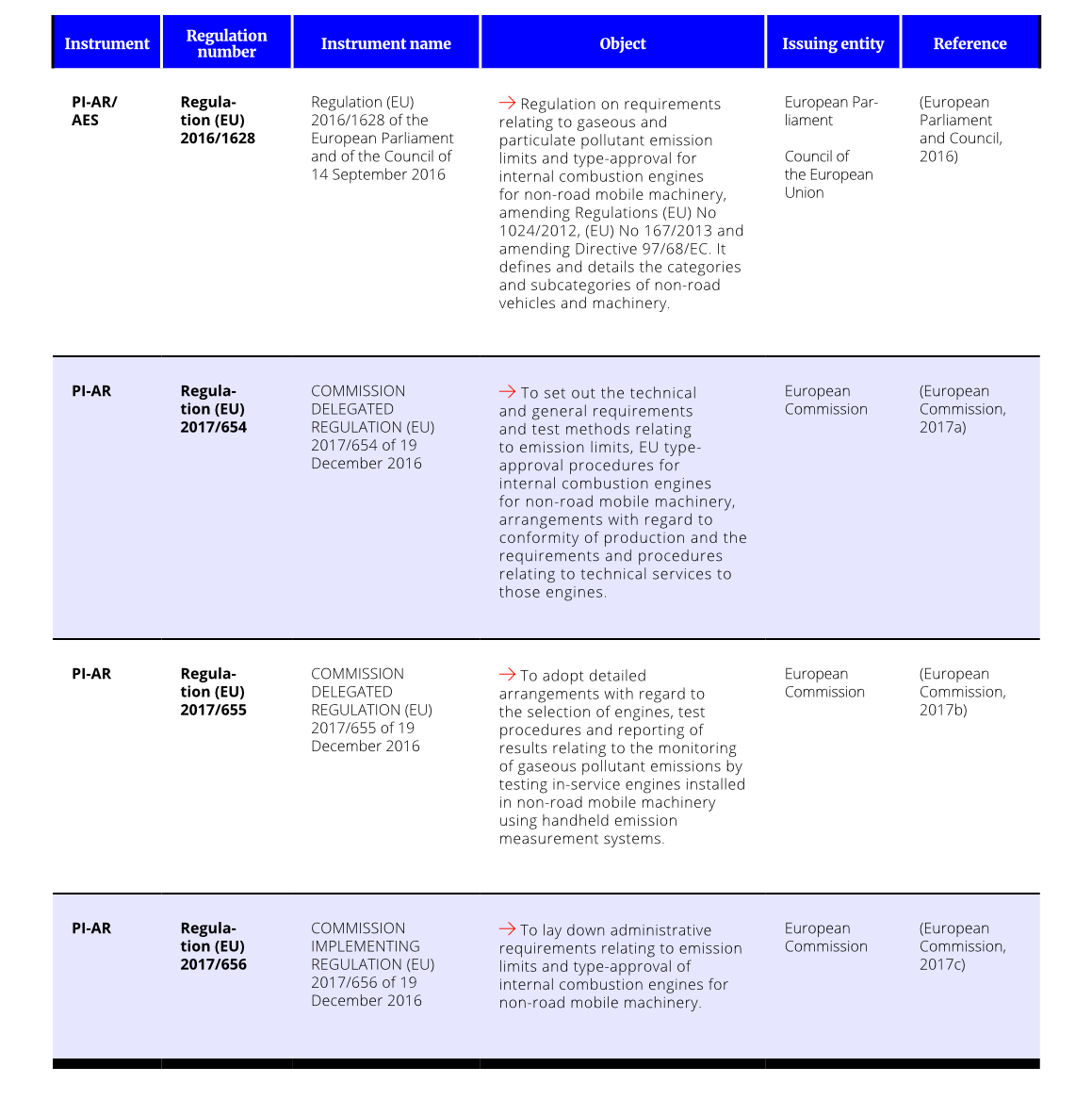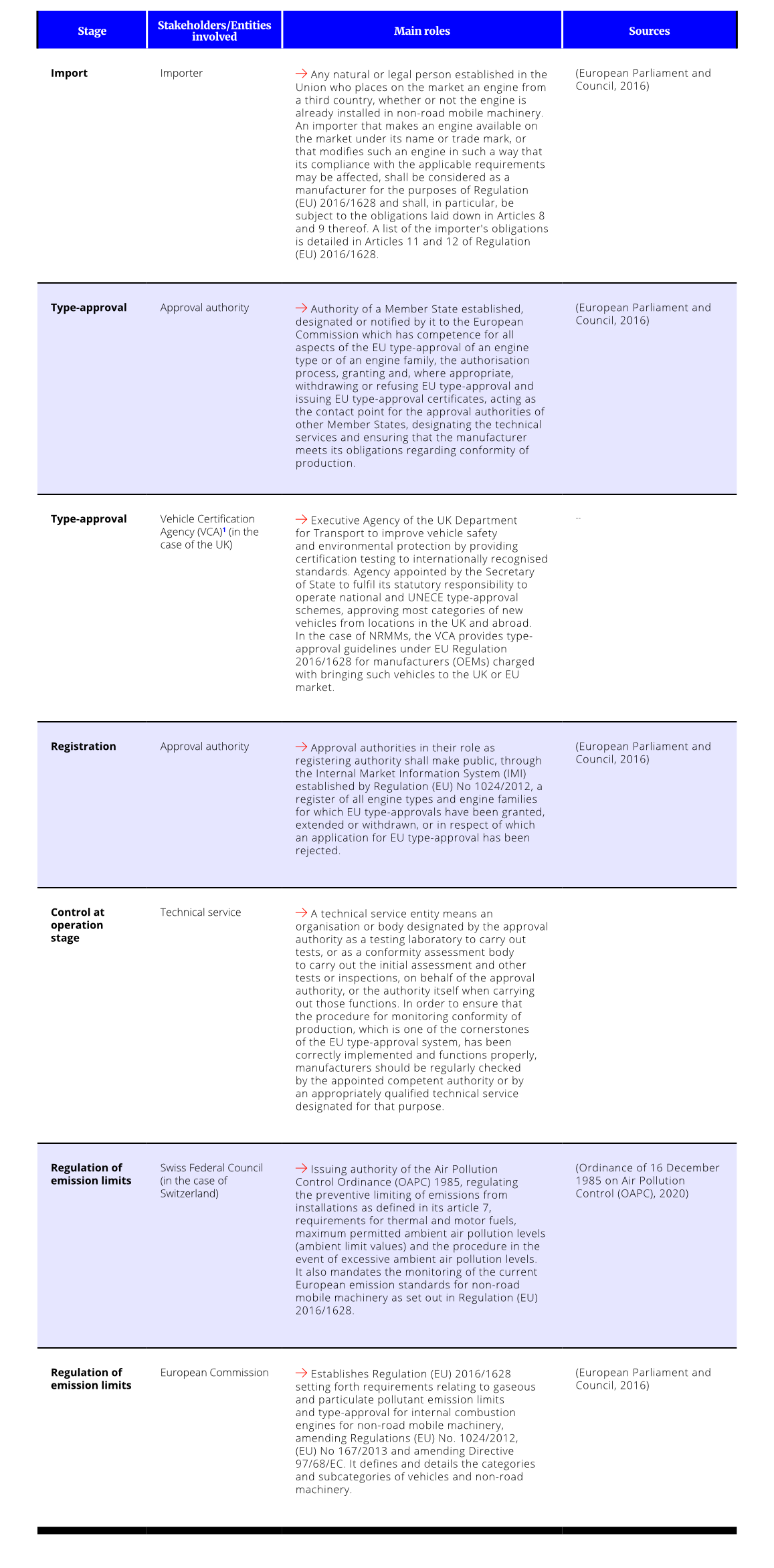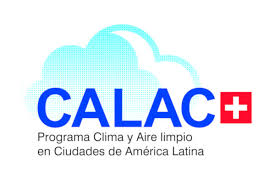EUROPEAN UNION

/1/
Definitions of
non-road mobile
machinery
For the European Union and the United Kingdom, the same provisions apply as those presented for Switzerland. The Swiss regulation is based on Regulation (EU) 2016/1628.

/2/
Main regulatory
instruments for NRMM
emissions reduction
Table 1 Presents a compilation of different types of instruments identified in the European Union for the control of air pollution generated by NRMM.
TABLE 1
Regulatory framework and identification of tools to reduce MMNC emissions – European Union.

Fuente: elaboración propia.

/3/
Emission standards
for air pollutants
For the European Union and the United Kingdom, the same provisions apply as those presented for Switzerland. The Swiss regulation is based on Regulation (EU) 2016/1628.

/4/
Import requirements
and type-approval
processes
The same provisions apply for the type-approval process in the European Union and in the United Kingdom as for Switzerland. The Swiss regulation is based on Regulation (EU) 2016/1628.

/5/
Labelling
processes
For the European Union and the United Kingdom, the same provisions apply as those presented for Switzerland. The Swiss regulation is based on Regulation (EU) 2016/1628.

/6/
Regulation on machinery
useful life, repowering, overhaul and
scrapping practices
For the European Union and the United Kingdom, the same provisions apply as those presented for Switzerland. The Swiss regulation is based on Regulation (EU) 2016/1628.

/7/
Operational and road
circulation requirements
For the European Union and the United Kingdom, the same provisions apply as those presented for Switzerland. The Swiss regulation is based on Regulation (EU) 2016/1628.

/8/
Procedures for NRMM
control and inspection
in the operation stage
No hay para la Unión Europea

/9/
Actors in import processes, manufacturing, registration, marketing, control and final practices of useful life of the MMNC
For the European Union, Switzerland and the United Kingdom, the stakeholders listed in the table below apply. In some cases where only one applies, it is explicitly mentioned. Further aspects of these processes are presented below.
TABLE 2
Regulatory framework and identification of NRMM emission reduction tools – European Union.

Source: self made.
The EU regulation defines the stakeholders as follows.
Import
Importer: any natural or legal person established in the Union who places on the market an engine from a third country, whether or not the engine is already installed in non-road mobile machinery. An importer that makes an engine available on the market under its name or trade mark, or that modifies such an engine in such a way that its compliance with the applicable requirements may be affected, shall be considered as a manufacturer for the purposes of Regulation (EU) 2016/1628 and shall, in particular, be subject to the obligations laid down in Articles 8 and 9 thereof. A list of the importer’s obligations is detailed in Articles 11 and 12 of Regulation (EU) 2016/1628.
Manufacturing and distribution
Manufacturer: the person or body who is responsible to the approval authority for all aspects of the type-approval or authorisation process of the EU engine type and for ensuring conformity of production of the engine, and who is also responsible for market surveillance issues of the engines produced, whether or not they are directly involved in all stages of the design and construction of the engine that is the subject of the EU type-approval process. A list of their obligations is detailed in Articles 8 and 9 of Regulation (EU) 2016/1628.
Manufacturer´s representative or ‘representative’: any natural or legal person established within the Union who has received a written mandate from a manufacturer to act on its behalf in relation to specified tasks with regard to the manufacturer´s obligation under the relevant Union harmonisation legislation or under the requirements on the Regulation. A list of their duties is set out in Article 10 of Regulation (EU) 2016/1628.
Economic operator: means the manufacturer, the authorised representative, the importer or the distributor. Economic operators and OEMs shall, upon request, notify the following to the approval and market surveillance authorities for a period of five years after the date of placing on the market:
- Any economic operator who has supplied them with an engine; and
- Any economic operator or, where identifiable, any OEM to whom they have supplied an engine.
Original equipment manufacturer or “OEM”: any natural or legal person that manufactures NRMM. A list of their obligations is detailed in Articles 15 and 17 of Regulation (EU) 2016/1628.
National authority: approval authority or any other authority involved in and responsible for the engines to be installed in the NRMM or for these vehicles in which the engines are installed, market surveillance, border control or placing on the market in a Member State of the European Union.
Approval authority: the authority of a Member State established, designated or notified by it to the European Commission and having competence for:
- All aspects of EU type-approval of an engine type or engine family;
- The authorisation process;
- Issuing and, if appropriate, withdrawing or refusing of EU type-approval certificates;
- Acting as the point of contact point for the approval authorities of other Member States;
- Designating technical services; and
- Ensuring that the manufacturer meets his obligations regarding conformity of production.
In compliance with the obligations of the member states of the European Union, as stipulated in Article 5(1) and (2) of Regulation (EU) 2016/1628, member states shall establish or appoint approval authorities and market surveillance authorities in accordance with the provisions of that Regulation, market surveillance authority: an authority of a Member State that is responsible for carrying out market surveillance in its territory, which refers to the activities carried out and the measures taken by national authorities to ensure that engines placed on the market comply with the relevant EU harmonisation legislation. specifying their names, postal and electronic addresses, as well as their areas of responsibility (European Parliament and Council, 2016). Updated as of 8 April 2021, the European Commission makes public on its website the list and details of the approval authorities for non-road mobile machinery in document Ref. Ares (2021)2410631 – 08/04/2021 (NRMM Emissions – Approval Authorities in the Member States, 2021), where it is noted that:
- in countries such as Greece, Italy, Slovakia and the Czech Republic correspond to their transport ministries;
- in Bulgaria, Denmark and France correspond to their ministries of environment or agriculture;
- in Hungary and Austria correspond to their ministries of innovation and technology;
- and in the case of Spain it is the Ministry of Industry, Trade and Tourism (NRMM Emissions – Approval Authorities in the Member States, 2021).
Registration and type-approval
Approval authority (registering authority): approval authorities shall make public, by means of the Internal Market Information System (IMI) established by Regulation (EU) No 1024/2012, a register of all engine types and engine families for which EU type-approvals have been granted, extended or withdrawn, or in respect of or which an application has been rejected. That register shall contain at least the following information:
- Name and address of manufacturer and name of the company name, if different;
- Trade name(s) or trade mark(s), as appropriate, belonging to the manufacturer;
- Designation of the engine types covered by the EU type-approval of the engine type or, where applicable, the EU type-approval of the engine family;
- Engine category;
- Number of the EU type-approval, including the number of any extensions;
- Date of granting, extension, refusal or withdrawal of the EU type-approval; and
- The contents of the sections ‘General engine information’ and ‘Final emission result’ of the test report referred to in Article 24(12) of Regulation (EU) 2016/1628.
Sale
Distributor: any natural or legal person in the supply chain, other than the manufacturer or the importer, who makes an engine available on the market. A distributor that makes an engine available on the market under its name or trade mark, or that modifies an engine in such a way that its compliance with the applicable requirements may be affected, shall be considered to be a manufacturer for the purposes of Regulation (EU) 2016/1628 and shall, in particular, be subject to the obligations laid down in Articles 8 and 9 thereof. A list of the distributor’s obligations is detailed in Articles 13 and 14 of Regulation (EU) 2016/1628.
Market surveillance authority: an authority of a Member State that is responsible for carrying out market surveillance in its territory, which refers to the activities carried out and the measures taken by national authorities to ensure that engines placed on the market comply with the relevant EU harmonisation legislation. The list of market surveillance authorities by sector and their contact information, updated as of September 2021 and published on the European Commission’s website, shows in paragraph 28 that in countries such as France and Germany their environment ministries are responsible, in Greece, Italy and Slovakia their transport ministries, in Hungary their Ministry of Innovation and Technology, while in Spain their Ministry of Industry, Trade and Tourism is responsible (European Commission, 2021).
End-user: any natural or legal person, other than the manufacturer, OEM, importer or distributor, that is responsible for operating the engine installed in NRMM.
End of life
As far as the disposal of vehicles is concerned, the measures established by the European Union do not make explicit their applicability to non-road mobile machinery. The European Union issued Directive 2000/53/EC of the European Parliament and of the Council, which aims to set forth measures to prevent and limit waste from end-of-life vehicles (ELVs) and their components by ensuring that they are reused, recycled or recovered, and to improve the effectiveness of environmental protection for all economic operators involved in the life cycle of vehicles. However, this legislation only applies to passenger cars and vans, but not to large trucks, vintage vehicles, special-purpose vehicles and motorbikes (Summary of Directive 2000/53/EC on End-of-Life Vehicles, 2000).
Other legislation such as Directive 2012/19/EU on waste electrical and electronic equipment, in its paragraph 4, point (e) also makes it explicit that the disposal measures laid down are not applicable to non-road mobile machinery (European Commission, 2012).
Consultation documents (downloadable)
